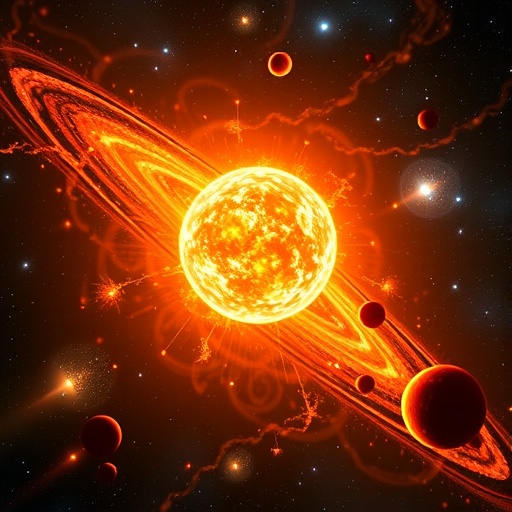Interstellar objects, those enigmatic wanderers from distant star systems, may hold the key to understanding planet formation in the cosmos. Recent developments suggest that objects like 3I/ATLAS, which has been captured by the gravitational pull of a young star, could be instrumental in the formation of new planets. These interstellar bodies, which share characteristics with asteroids and comets, have been observed drifting through the vast emptiness of space, and their journey through our Solar System has sparked interest among astronomers and astrophysicists alike.
Since the discovery of the first interstellar object, 1I/’Oumuamua in 2017, scientists have pondered the implications of these celestial nomads. Following 1I/’Oumuamua, researchers identified 2I/Borisov, and more recently 3I/ATLAS, discovered in the summer of 2025. These interstellar visitors raise intriguing questions about their capacity to interact with young stellar systems and their potential to act as building blocks in the creation of new worlds.
Professor Susanne Pfalzner, an astrophysicist from Forschungszentrum Jülich in Germany, has been at the forefront of exploring these possibilities. Her recent research, presented at the EPSC-DPS2025 Joint Meeting in Helsinki, brings to light the significant role interstellar objects might play in shaping planet formation, particularly around higher-mass stars. As planetary systems form within dusty discs around youthful stars, theoretical models have struggled to explain how larger bodies coalesce amidst the chaotic environment of a planet-forming disc. Pfalzner offers a fresh perspective, suggesting that interstellar objects may provide a solution to longstanding enigmas in planetary formation theory.
The process of accretion, which entails smaller particles merging to form larger ones, should ideally lead to the creation of planet-sized entities. Yet, researchers have grappled with the question of how bodies larger than a meter can form without fragmentation or bouncing apart during collisions in these turbulent environments. Pfalzner’s research sheds light on a potential avenue for bypassing this challenge through the gravitational capture of interstellar objects. By integrating these bodies into the dust-rich environment surrounding young stars, the formation of larger planetary bodies could be expedited.
Models constructed by Pfalzner reveal that the dusty discs of young stars could potentially capture millions of interstellar objects, similar in size to 1I/’Oumuamua, estimated to be about 100 meters long. The concept of these objects serving as “seeds” for planetary formation presents a refreshing narrative—the idea that interstellar space may deliver the necessary ingredients for the next generation of planets. This notion has profound implications, suggesting a new framework for understanding how planets form in various environments across the galaxy.
Interestingly, this captures another vital aspect of planetary formation, especially concerning gas giants like Jupiter, which are scarce around the smallest stars, known as M dwarfs. It has been a conundrum in astronomy why gas giants tend to orbit more massive stars similar to the Sun. The window of time available for planet formation around such stars is approximately two million years, which presents a challenge for the formation of giant planets given the relatively short lifespan of these discs before they dissipate. Pfalzner’s findings indicate that the introduction of interstellar objects as seeds could dramatically alter the timescale, facilitating the swift formation of gas giants within the limited timeframe.
Pfalzner’s work emphasizes that higher-mass stars are more adept at capturing interstellar objects within their disc environments. Consequently, the onset of planet formation seeded by these interstellar bodies could be expedited around such stars. This efficient capture process aligns with observational data, reinforcing the hypothesis that the presence of interstellar objects could lead to a faster timeline for the formation of gas giants.
One of the most intriguing aspects of Pfalzner’s research is the prospect of modeling the capture success rate of interstellar objects. Delving into the specifics of how many of these captured bodies can evolve into planetary formations remains a critical avenue for further investigation. Additionally, the distribution of these captured objects within the planet-forming disc poses another layer of complexity—whether they are evenly spread throughout, or concentrated in specific regions that may emerge as hotspots for planetary births.
The implications stemming from this research are monumental, not merely altering our understanding of how planets form but also reshaping our comprehension of the scaling laws governing planet formation in various stellar environments. By recognizing the potential influence of interstellar objects, Pfalzner’s findings pave the way for a more nuanced understanding of cosmic evolution. All these considerations lead scientists closer to unlocking the mysteries of the universe, adding profound depth to our studies of planetary formation and the diverse environments in which these celestial bodies arise.
As astronomers continue their explorations into the vast curation of interstellar objects, the findings resonate across disciplines, igniting curiosity and expansive thought about the cosmos. The connection between these drifting bodies and the birth of new planets evokes a sense of wonder about the cycles of creation and destruction inherent in the universe. Understanding the significance of interstellar objects could transform not only our grasp of how planets come into existence but also our perception of our place in the cosmos.
In the coming years, as researchers like Pfalzner probe deeper into these phenomena, the answers they uncover could reshape the trajectory of planetary science, offering fresh insights and perhaps even triggering new paradigms in astrophysical inquiry. The surge of interest in interstellar objects harbors the potential not just for scientific discovery, but for a greater appreciation of the cosmic tapestry interwoven throughout the universe.
Subject of Research: Interstellar Objects and Planet Formation
Article Title: Interstellar Objects as Seeders of New Planets
News Publication Date: [Date Not Provided]
Web References: [Not Provided]
References: [Not Provided]
Image Credits: NASA/ESA/David Jewitt (UCLA). Image Processing: Joseph DePasquale (STScI).
Keywords
Interstellar objects, planet formation, 1I/’Oumuamua, 2I/Borisov, 3I/ATLAS, planetary science, astrophysics, gas giants, solar system, young stars.




